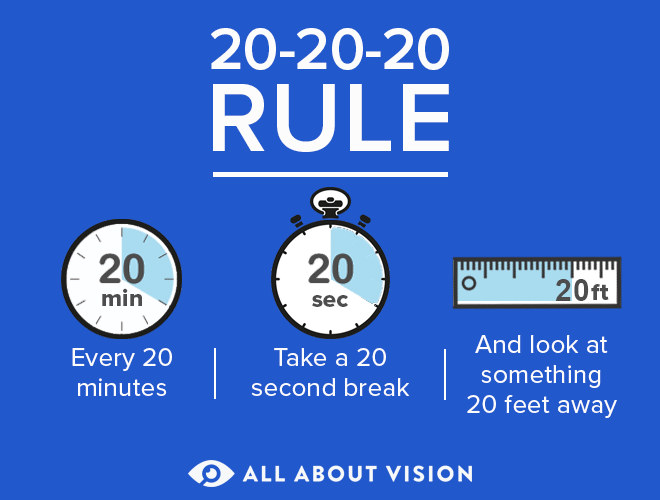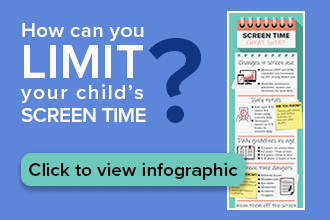What are the effects of too much screen time?

Digital screens aren’t going anywhere. What does that mean for your child’s vision?
Parenting is a grueling job. It’s exhausting to deny the constant pleas for more video games, Netflix, phone time... Is it worth the drama just to shave an hour off of your kids’ daily screen time? Experts say yes. Too much screen may be harmful to vision as well as overall development.
How does screen time affect your child’s vision development?
As a parent, the term “screen time” may bring to mind the (fairly accurate) image of your kids mindlessly staring for hours at a screen. They forget to blink, eat or use the bathroom.
As most parents know, peeling kids away from their screens is not in the top five most enjoyable ways to spend family time. Unfortunately, the cumulative effects of too much screen time appear to have more negative consequences than previously known.
Extended screen time, such as playing a video game or working on a laptop, can cause eye strain. Spending many consecutive hours focused on near work may also be associated with myopia development, according to vision studies. This is grim news when, on average, American children ages 8-12 years are clocking in four to six hours of screen time a day, and teens up to nine hours a day.
Does too much screen time cause nearsightedness?
There is an epidemic of nearsightedness that has swept through most developed countries in the past few decades. The rates of myopia have increased so much, scientists expect that in 30 years about half of the world’s population will be nearsighted. This means that nearly five billion people will have myopia by 2050.
What’s driving this wave of nearsightedness? Scientists point to several possibilities. One of these is the significant increase in near work, including screen time.
Scientists are still investigating the link between near work, screen time and myopia progression. They have found evidence that increased screen time may play a role in the rising rates of myopia around the world.
A 2021 meta-analysis looked at 33 research articles investigating the link between myopia development and smart devices. This review concluded that exposure to smart devices (smart phones and tablets), combined with computer screens, might be associated with an increased risk of myopia development.
A 2020 study conducted by Spanish vision researchers found that nearsighted children spent more time looking at screens. And they spent less time outside per day than their peers who did not have myopia. More work needs to be done to examine this relationship. Still, it is an important reminder to encourage kids to spend less time looking at their phones and devices.
The good news is that recent studies indicate that spending time outside during the day can actually protect against myopia. The activity does not have to be anything more complicated than taking a walk, playing a sport or running around with friends.
The effects of too much screen time and not enough time in outdoor daylight may compound. A 2017 study showed that children who spent little time outdoors during the day were found to have a 5X higher risk of myopia.
Those who spent little time outdoors and also spent a lot of time focusing up close were found to have an astounding 16X risk of myopia development.
A majority of pediatric ophthalmologists have already begun to advise against too much screen time as a way to decrease myopia risk. An even greater majority recommend more time outdoors for children as a myopia control strategy.
SEE RELATED: How to help children avoid computer vision syndrome
Does too much screen time cause eye strain?
Our eyes are not optimized for long periods of near focus. When we become engrossed with what is happening on the screen, several hours can pass before we realize that we haven’t looked away. When this happens repeatedly over a period of time, eye strain can result.
Computers and tablets are becoming increasingly common at work and school. As a result, more adults and children are experiencing eye fatigue and eye strain. Computer vision syndrome (also called digital eye strain) and extended use of digital devices are leading causes of eye strain.
Symptoms of eye strain may begin during screen time but can continue even afterward. If your eyes experience daily strain and do not have a chance to rest, symptoms begin sooner and last longer.
Symptoms of eye strain caused by too much screen time include:
It’s common for symptoms to be worse later in the day than in the morning when your eyes are fully rested.
How can I decrease eye strain and the risk of myopia?
One of the best strategies to relieve eye strain and decrease your risk of myopia according to researchers is to lessen screen time. And spend time outside in the daylight every day.
In addition, some simple technology and lifestyle changes can be quite helpful in relieving symptoms of eye strain.
Technology recommendations
Adjust font and background color to increase comfort and readability.
Place glare-reducing filters on computer screens.
Wear designated computer glasses with a prescription for intermediate vision.
Use blue light filtering glasses that may make the screen more comfortable to view.
SEE RELATED: Computer ergonomics and healthy vision
Lifestyle and environmental recommendations

Blink – when looking at a screen, the rate at which we blink can be reduced by half.
Apply artificial tears or warm compresses when eyes feel irritated and dry.
Take visual breaks – an easy way to remember this is the 20-20-20 rule (every 20 minutes, for 20 seconds, look at something at least 20 feet away).
Optimize the height of the desk, chair and screen to maintain comfortable posture.
Ensure that lighting is bright but not too harsh and directed away from the eyes.
Maintain regular sleep hours
Stay hydrated
If your child is experiencing eye strain or blurry vision, schedule a visit with an eye doctor. Stay current on comprehensive eye exams. This will allow your doctor to monitor any eye strain and myopia symptoms your child may be experiencing.
Encourage your child to take a break from devices and spend some time outside. Fresh air and outdoor recreation have many benefits — decreasing the risk of eye strain and myopia can now be added to the list. And parents, remember this advice applies to adults too!
Does too much screen time affect healthy child development?
Selling screen time to kids is big business. You can find videos and entertainment marketed as “educational” to babies only a few months old. Exhausted parents, desperate for a break or a shower, find themselves permitting levels of screen time that would have shocked them pre-parenthood.
As children grow older, screen time naturally expands to take up larger portions of the day. Parents may begin to feel helpless, not knowing how to turn the ship around.
But, the truth is, too much screen time causes not only vision problems. It is also associated with developmental and emotional problems as well.
A 2019 study of nearly 2,500 children found that children 2 to 3 years old who were exposed to higher levels of screen time performed worse on tests for behavioral, social and cognitive development.
Another recent study examined the relationship between the amount of screen time at age 16 and the onset of depression at age 18. The study found that there was an increased risk of anxiety and depression in kids who logged in more screen time.
This is rather concerning if you consider that the Pew Research Center reports that 95% of teens either own a smartphone or have access to one. Nearly half of these teens say that they are online nearly constantly.
Children with increased screen time, regardless of age, were also found to have worse sleep quality. They also had more behavioral problems than their peers.
While there may be other factors at play, these studies highlight the fact that parents should be mindful of the developmental effects of too much screen time.
The American Academy of Child and Adolescent Psychiatry (AACAP) offers the following guidelines for healthy restrictions to daily screen time:
Ages 18 to 24 months– Limit to watching educational programs with caregiver,
Ages 2 to 5 years– Allow one hour or less on weekdays and up to three hours on weekend days.
Ages 6+– Implement healthy habits and routines that limit screen time.
How can I decrease screen time in my household?
Healthier eyes, decreased long-term myopia risk and improved well-being are only a few of the benefits of decreased screen time in a child’s daily routine.
It can feel overwhelming to implement changes. Especially when a child will probably fight tooth and nail clinging to every extra minute of screen time. It's best to start slow and to make small changes. Decreasing screen time will open up the day for more healthy and productive activities. Spending that time outside may even have lifelong benefits for vision.
AACAP recommends some simple ways to decrease screen time in your household:
No screens during family meals
No screens during outings
Use of parental controls
No use of screens as alternative babysitters
No screens in bedrooms for ½ hour to 1 hour before bedtime
Whether you have little ones or teenagers, have discussions about how to make healthy decisions about screen time. Let them know that healthy screen time choices are as important as healthy food choices.
Social media, video games, YouTube, TikTok… kids have an endless stream of screen time entertainment to occupy them.
So it is up to us to pull the plug after a few hours and push their squinting and pouting outside into the sunshine. While it’s a painful process for both parents and kids, less screen time and more outside time leads to healthier bodies, minds and eyes.
READ NEXT: How much screen time is okay for my child?
Screen time and children. American Academy of Child and Adolescent Psychiatry. February 2020.
Global prevalence of myopia and high myopia and temporal trends from 2000 through 2050. Ophthalmology. May 2016.
Association between digital smart device use and myopia: A systematic review and meta-analysis. The Lancet Digital Health. December 2021.
The relationship between screen and outdoor time with rates of myopia in Spanish children. Frontiers in Public Health. October 2020.
Association of time outdoors and patterns of light exposure with myopia in children. British Journal of Ophthalmology. April 2021.
Preventing myopia. Dtsch Arztebl Int. 2017.
Current trends among pediatric ophthalmologists to decrease myopia progression — an international perspective. Graefe's Archive for Clinical and Experimental Ophthalmology. August 2018.
Asthenopia. American Academy of Ophthalmology. EyeWiki. August 2021.
Headaches. Nelson Pediatric Symptom-Based Diagnosis. Elsevier ScienceDirect. 2018.
Does more screen time put your child’s eyes at risk? Duke Health. September 2020.
Asthenopia among university students: The eye of the digital generation. Journal of Family Medicine and Primary Care. August 2020.
Association between screen time and children’s performance on a developmental screening test. JAMA Pediatrics. January 2019.
Is screen time associated with anxiety or depression in young people? Results from a UK birth cohort. BMC Public Health. January 2019.
Teens, social media & technology 2018. Pew Research Center. May 2018.
Youth screen time and behavioral health problems: The role of sleep duration and disturbances. Journal of Developmental & Behavioral Pediatrics. May 2016.
Page published on Tuesday, April 26, 2022
Page updated on Monday, April 25, 2022








